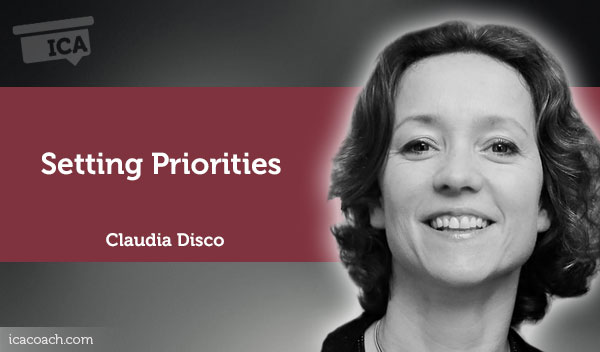Coaching Case Study By Claudia Disco
(Expatriate Coach, UNITED STATES)
1. Who are the main players in this case study
The main players in this case study are myself and an ICA peer coach. Let’s call her my client.
2. What is the core problem or challenge you applied your coaching skills to?
My client’s challenge is to slow down and clear her mind. She needs to see clearly what the priorities are for her the coming 2 months before her move back home.
- Why is it a problem?
My client states that she is doing too much at the same time and she is exhausted and has no more energy. The next 2 months will be very busy as my client wants to finish her ICA program before her move back home.
- How long has it been a problem?
As a coach I have not clearly defined with my client how long exactly this has been a problem. The client has made clear that the problem exists now.
- What is the worst thing about this problem?
The client states that she feels she is running around like a headless chicken. Her brain has too many tabs open. She does not feel she is fully present, clear her mind and give her undivided attention.
- Why has no one been able to solve it so far?
During the coaching sessions the pressure from her environment kept increasing, consequently pushing her to have to take more actions.
2. What specific coaching skills or approach did you use in this case?
Listening, visualisation, challenging questions and creating an action plan.
3. Explain your process in detail
As a coach I apply the GROW model. I start of identifying the goal of the session using the question What do you want to get out of this session? And What is the main challenge here for you? Then I progress into the reality of the situation. What kind of ….? Where? Moving on to the options to finally ask the Will or Action questions like; What action can you commit to? What will help you be accountable?
4. What were the results of your process? Was your coaching/program effective? Why? Why not?
I coached my client 3 times and I feel that the client did not make any progress. There was a concrete action plan at the end of each session. However, every session would be around the similar challenge of having too much on her plate. I feel the action plans were similar every time and that they did not deal with the underlying issue.
5. If you could approach this problem again, what would you do differently?
- Take more time to establish the objective of the coaching session by drilling down and agreeing on one issue before moving on.
- My client had so many things going on I, as a coach, got lost in the story
- Drill down more on the underlying emotions.
- Challenge my client. Help her get out of the story by just making a simple observation (eg. I notice that you are in a hurry to set-up an action plan).
- Slow her down by using silences (Eg. I see that you already know what actions you want to take, so what is the real issue for your).
- Challenge myself. Why do I find it difficult to coach somebody who is just being coached to set-up an action plan?
- Be aware of not pushing her into a direction that I wanted her to move into.
6. What are the top 3 things you learnt from this experience?
- As a coach I am responsible for giving a structure to the session. Meaning that I need to help the client get out of the story and dig deeper into the underlying issues that are challenging. I applied the GROW model during our sessions but was too much lead by the client’s wish for action plans.
- I realise that as coach, if we apply structure and make observations, it is still up to the client to make progress. As a coach, I can apply what I discussed in #1, but if the client is not willing or ready to take that path than I can not force the client.
- Finally, as a coach I do feel that we can interrupt a client who has a tendency to speak a lot and get stuck in the story. I can do that through making an observation followed by a question. And not being afraid of insisting and repeating the observation.
